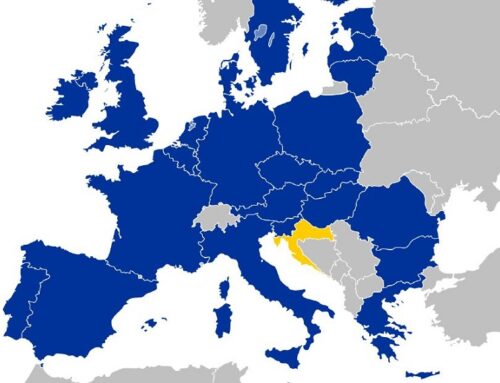Chiara Pontin
When talking about minorities in MOSO, Ukraine represents an extremely interesting case given its rich and complicated ethnolinguistic structure. According to the last census of 2001 in Ukraine, about 78% of the population identifies itself as ethnic Ukrainian; the most widespread minority is the Russian one (about 17%), and then there are more than 130 others, constituting less than 1% of the total population.[1]
The presence of a vast multitude of populations and ethnic groups represents a richness for the cultural heritage of a country, but it also poses the issue of integrating this multitude in a society – the Ukrainian one – which has already been struggling with the process of nation-building ever since it gained independence.
To further complicate the picture, there is the fact that ethnic differences do not coincide with linguistic differences: the use of Russian is not limited to the borders of the Russian minority, but also involves large portions of the population that defines itself as ethnic Ukrainian so that the Ukrainian-speaking and Russian-speaking communities come to constitute two almost equal halves.[2]
An even more particular case is that of Crimea, the only part of Ukraine where, along with a fair presence of Crimean Tatars, the ethnic Ukrainian population is outnumbered by the Russian one.[3]
Over time, this has resulted in a truly complicated internal situation, with a deeply divided society and where inter-ethnic relations are far from simple. In 2014, inter-ethnic tensions culminated in the incorporation of Crimea into the territory of the Russian Federation and in a real armed conflict that has been going on for seven years now.
This paper presents the results of an analysis that was conducted on the Ukrainian legislative framework on national minorities in order to understand the main unresolved issues between Ukraine and its internal minorities and investigate whether they might be attributable to a lack of adequate legislative standards in the protection and promotion of minority rights at the national level.
The question today is more topical than ever, not only because the protection of minorities is one of the most important issues on the international agenda, but also because Ukraine’s future in the region will depend to a large extent on its ability to integrate its multitude of minorities into a clear and comprehensive legislative system of rights protection. This future encompasses two major objectives: the accession to the European Union, subject among others to respect for the rights of persons belonging to minorities,[4] and the accession to NATO, currently vetoed by Hungary precisely – as we will see – because of disputes over national minority rights protection.[5]
Premise: international legislative and historical frameworks
To fully understand the complexity of the relationship between Ukraine and its national minorities, it is first of all essential to provide two types of contextualization.
The first one involves the international legislative framework and its shortcomings.
Over time, the topic of minority rights has gained centrality on the international agenda. The body of international law has been increasingly devoted to the issue, with many international bodies involved and instruments adopted. However, international law still presents some major problems when speaking about minority rights protection. The most critical issue is the lack of a universally accepted definition of what constitutes a national minority: despite numerous proposals, indeed, no one, academic or international organization, has been able to provide a definition over which the international community has been able to agree on.[6]
This gives rise to several additional problems, the main one being the lack of international recognition. In fact, in the absence of an official definition, the decision on whether and to what extent to recognize minorities is left to states’ discretion,[7] which inevitably contributes to an impasse that is unlikely to be overcome in the near future. A further complication is the plurality of categories falling under the term ‘minorities’. The paper deals only with what we might call ‘ethnic minorities’, and not with so-called ‘marginal groups’, yet even within the category of ethnic minorities we have multiple subcategories, among which old and new minorities, dispersed minorities, indigenous peoples, etc. This further complicates the efforts to provide a comprehensive and integrated international protection system for minorities.
The second fundamental contextualization to bear in mind is the historical one.
Ukraine’s diverse linguistic and cultural profile results from an eventful past, during which, since the domination of the Russian Empire, peoples inhabiting this territory have been involved in a continuous succession of different policies.
Even within the Tsarist rule itself, during its 200-year history, various approaches to the nationalities residing in the territory were adopted, where harsh repression and waves of Russification alternated with periods of greater freedom and rights. Moreover, these policies differed substantially between different territories and different nationalities, so that it is almost impossible to identify a single linear and coherent policy.[8]
In the Soviet era, too, we cannot speak of homogeneity in nationality policies. Immediately after the Bolsheviks seized power, to prevail were the policies of the party leader Vladimir Lenin, who had already shown a strong sensitivity to this issue long before the Revolution.[9]
This first phase of the Soviet period, from the early 1920s until 1928, went down in history as ‘korenizatsiya‘, a term that defined the Soviet nation-building policy based on the principle of ‘indigenization’, as opposed to the forced assimilation of Russian language and culture.[10] The year 1928 marked instead the beginning of a new phase. With Lenin’s death, the new party leader became Iosif Stalin, who initially seemed keen to follow his predecessor’s footsteps. However, Stalin soon proved to have completely different ideas: indigenization was replaced by Sovietization, with the aim of achieving Communism within the time of a generation, resulting in a series of brutal actions that helped define Stalinist era as the ‘Great Terror’.[11]
In the last years of its existence, the USSR saw alternating phases of openness and repression. By then, however, nationalist sentiment was already spreading throughout the territories of the Empire, and it came to constitute one of the decisive factors in the collapse of the Soviet Union.[12]
Providing these two contexts was critical in order to be able to respectively compare the Ukrainian legislation on minorities with current international standards and understand how complicated it has been and still is managing heterogeneous communities, trying to unite them under a single national identity.
Ukraine and national minorities: compliance with international standards
The study conducted has involved the analysis of the main tools adopted by the Ukrainian authorities in these two decades of independence, focusing on three fields: general legislation, language policy, and education.
In the first place, the Fundamental Law of Ukraine was analyzed. Promulgated in 2006, the Constitution is the main source of rights for minorities in the country. It was amended in 2004 and, since the events of Euromaidan, has been at the center of an ongoing debate on the need for reform. The analysis also involved the first Ukrainian law dedicated to minorities, entitled ‘on National Minorities’ and introduced in 1992.
Secondly, the analysis moved to the most important language laws promulgated in the country since 1989, when Ukraine was not yet a nation but was still a Soviet Socialist Republic. Until 2012, the 1989 ‘Law on Languages in the Ukrainian SSR’ was the sole law dedicated to linguistic issues in the country. Only on 3 July 2012, a new language law was promulgated, ‘on the Principles of State Language Policy’, which remained in force until 2018, when it was declared unconstitutional. In July 2019, the ‘Law on Ensuring the Functioning of Ukrainian as the State Language’ came into force and is currently the most updated law on languages in Ukraine.
Thirdly, we have dealt with the educational sphere. In particular, two laws were analyzed: the Law on Education of 2017, whose Article 7 has triggered a harsh controversy with Ukraine’s neighboring countries and a dispute over compliance with international law, and the recent ‘Law on Complete General Secondary Education’, adopted in 2020.
To determine whether the instruments introduced by Ukraine in these two decades should be considered sufficient and effective, the study made extensive use of the opinions of the Advisory Committee on the Framework Convention on the protection of National Minorities.
Summary of key findings
The general impression is that Ukraine is striving to ensure a good level of protection for its minorities, in light of international pressure and high expectations, both from European institutions and foreign states representing their diasporas in the country. This is for instance confirmed by the accession of Ukraine to the Framework Convention for the Protection of Minorities (1998), and to the European Charter for Regional or Minority Languages (2006), despite 13 years of internal disputes.
Nevertheless, there are still several deadlocks hindering the full protection of minorities in the country. Below are summarized the main issues that emerged during the research, supported by examples from the laws analyzed.
The first deadlock is represented by the ongoing clash between (ethnic) Ukrainians and Russophones. The tug of war to confer Russian a more prominent role – or even declare it a state language – has been going on since Ukraine has obtained independence. Although the Russian-speaking component constitutes almost half of the total, a sort of hierarchy of languages emerges in the country: Ukrainian is the only official language in a multi-ethnic country made up of equal minority languages, where Russian is recognized a limited and non-formal relevance.
A fitting example is the Constitution of 1996,[13] which guarantees “the free development, use and protection of Russian and other languages of national minorities” (Article 10). The formulation of this article gives relevance to Russian among all other minority languages, as it expressly mentions it, without however considering it equal to Ukrainian. Indeed, if on the one hand Russian is allowed to “develop freely”, on the other, the Constitution recognizes Ukrainian as the only official state language and provides for its active promotion for “the consolidation and development of the Ukrainian nation” (Article 11).
The same hierarchy is confirmed in the 1989 Law on Languages in the Ukrainian SSR,[14] where Russian, although not recognized as an official language, is frequently mentioned throughout the text and given greater prominence than other minority languages. For instance, the preamble gives Russian a particular “social value”, that is being the “language of interethnic communication of the peoples” in the USSR.
Expanding the use of the Russian language and giving it a semi-official status was the goal of the 2012 Law on the Principles of State Language Policy.[15] The process experienced by this law has not been simple and linear. The text has aroused several controversies and despite a two-year period in which the law was in force, in 2014, national ferment in the context of the Euromaidan protests has momentarily compromised its effectiveness. Since 2019, the Law on Ensuring the Functioning of Ukrainian as the State Language is in effect,[16] proclaiming once again the supremacy of Ukrainian over Russian.
To date, the denied official status of Russian along with Ukrainian “is one of the most serious inter-ethnic issues in the country”,[17] but the continuous clash between the two is evidently to the detriment of other minorities who, although present in a smaller measure, deserve just as much attention and protection at the national level.
Another problem in Ukraine is the poor dialogue between the central government and representatives of minorities. The scarcity of consultations between the two often gives place to situations where a certain law is adopted, but the opinions and needs of the groups directly involved and affected have not been taken into consideration at all.
The laws enacted in the field of education perfectly reflect Ukraine’s lack of attention to the needs of its minorities. For example, the 2017 Law on Education[18] quickly became an extremely controversial issue, which had resonance among international bodies[19] as well as foreign states, who stepped up in defense of their correspondent minority in Ukraine.
The law provided for a gradual phasing out of minority language instruction over the school years, until at the 11th grade almost all subjects would have been in Ukrainian (Article 7).
As soon as the law was adopted, Romania, Russia, Moldova, Bulgaria, Greece, and Hungary expressed their contrariety to the law and tried to push for the text to be vetoed or amended.[20] The tensions between Hungary and Ukraine, in particular, are the ones that have led to more disruptive international developments: at the end of October 2019, the Hungarian government vetoed the accession of Ukraine to NATO,[21] and since then the relationship between the two countries remains tense.
The Parliamentary Assembly of the Council of Europe admonished Ukraine for the absence of dialogue with representatives of national minorities concerning Article 7,[22] but this was not the only case in which minorities have been excluded in the process of drafting a law. The same happened, for instance, with the 1992 Law On National Minorities. The Advisory Committee criticized the Law in 2012 for including the population of Ruthenians among sub-ethnic groups, “based on extensive research conducted by academics and independent experts”, although this group was claiming its protection as a national minority.[23] In 2018, in its fourth and to date last Opinion, the Committee reiterated its idea and invited Ukrainian authorities to renew the legislative framework “in close consultation with representatives of the groups concerned”.[24] However, no new law dedicated to minority issues has ever been discussed.
The most recent developments in the educational sphere took place in 2020, with the adoption in 2020 of the Law on Complete General Secondary Education.[25] Among other provisions, the Law contains three language learning models (Article 5). According to the first model, schools can teach all subjects in a minority or indigenous language, who do not live in a language environment and do not possess their state, together with Ukrainian, during all grades, from the first to the last one. This is the case with Crimean Tatars.
The second model provides that national minorities speaking one of the official languages of the European Union can study in their language only in nursery and elementary school, until 4th grade, while from the 5th grade on, at least 20% of the total study time should take place in Ukrainian, in 9th grade – at least 40% and in high school – at least 60%. Inevitably, this law worsened the already strained relations between Ukraine and countries such as Romania and Hungary. The latter affirmed that the law “would contribute to the loss of language, the withering of national culture, the isolation of some communities linked to the Hungarian language and the rapid dissolution of others”.[26]
The same happened with Russia because of the third model described by the law. Dedicated to languages pertaining to the same group of the Ukrainian language and to minorities who reside in areas where only a particular minority language is spoken, like Russian, Belarusian, and Yiddish, the last model provides that students will be able to receive education in their native language up to the 5th grade, while from that moment on, at least 80% of education will be in Ukrainian.
The Russian Foreign Ministry issued a comment on the draft law, affirming that, despite the recommendations of international bodies on providing a balance in the language sphere, in Ukraine “nothing has changed” and Russian continues to be subjected to discrimination.[27]
Furthermore, beyond the issues that emerged from the analysis of the Ukrainian legislative framework, account must be taken of the geopolitical situation in the country in terms of stability and security. This inevitably represents a major – if not the biggest – impasse in the protection of minorities and indigenous peoples in Ukraine, further hindering and delaying an already toilsome process.
Overall, despite a quite evident positive approach of the authorities aimed at improving the situation, the Ukrainian legal framework for protecting and promoting the rights of national minorities results incomplete, ambiguous, and poorly integrated. This is probably also due to a society that, since the dawn of its history as an independent nation, is still searching for its own identity. The task is by no means easy for a territory that is home to more than 130 cultures and traditions.
If this research confirmed Ukraine’s tortuous and still incomplete path towards full protection of its minorities, it is however important to recall that international law itself still presents major gaps: the lack of a universally accepted definition and the lack of recognition of minorities remain the major obstacles to the full protection of minorities at the international level. To conclude, to date it is very complicated to attribute a certain backwardness to the Ukrainian legislative system regarding minority rights protection, in the light of an international system that perhaps still needs to develop fully.
References:
[1] About number and composition population of Ukraine by data All-Ukrainian population census – 2001 data. Available at: http://2001.ukrcensus.gov.ua/eng/results/general/nationality/
[2] Vseukraiynskyi perepys naselenniia, Derzhavna sluzhba statistiki Ukraini. Available in Ukrainian at: http://www.ukrcensus.gov.ua
[3] About the number and composition of the population of the Autonomous Republic of Crimea by data All-Ukrainian population census, op. cit.
[4] Consolidated version of the Treaty of the European Union, 2012, Article 2 and 49. Available at: https://eur-lex.europa.eu/resource.html?uri=cellar:2bf140bf-a3f8-4ab2-b506-fd71826e6da6.0023.02/DOC_1&format=PDF
[5] Hungary vetoes NATO statement on Ukraine over minority rights: minister, 30 October 2019. Online article available at: https://www.reuters.com/article/us-hungary-nato-ukraine-idUSKBN1X91ZI
[6] Several examples of attempts can be found at: Permanent Court of International Justice, Greco-Bulgarian Communities, Advisory Opinion, 1930 P.C.I.J. (ser. B) No. 17 (July 31). Available at: https://www.icj-cij.org/public/files/permanent-court-of-international-justice/serie_B/B_17/01_Communautes_greco-bulgares_Avis_consultatif.pdf; United Nations, Minority Rights: International Standards and Guidance for Implementation, New York and Geneva, 2010, p. 2. Available at: https://www.ohchr.org/Documents/Publications/MinorityRights_en.pdf; Deschênes, J., Proposal concerning a definition of the term UNDOC E/CN.4/ Sub.2/1985/31. Cited in Alam, A., Minority Rights under International Law, Journal of the Indian Institute, July-September 2015, vol. 57, No. 3, p. 379; Parliamentary Assembly, Recommendation 1201, adopted 1 February 1993, Additional protocol on the rights of national minorities to the European Convention on Human Rights. Available at: http://assembly.coe.int/nw/xml/XRef/Xref-XML2HTML-en.asp?fileid=15235.
[7] See, for instance, the declarations made by France and Turkey when they decided not to sign the Framework Convention.
[8] Pavlenko, A., Linguistic russification in the Russian Empire: Peasants into Russians? Языковая руссификация в Российской империи: cтали ли крестьяне русскими?, Russian Linguistics, Vol. 35, No. 3, 2011, pp. 331-350
[9] Graziosi, A., L’Unione Sovietica 1914-1991, Mulino, 2011, pp. 29-30; Lenin, V. I., Theses on the National Question, written in 1913 and first published in 1925 in the Lenin Miscellany III. Available at: https://www.marxists.org/archive/lenin/works/1913/jun/30.htm;
[10] Suny, R. G. & Martin, T., A State of Nations. Empire and Nation-making in the Age of Lenin and Stalin, Oxford University Press, Oxford 2001, p. 74
[11] Flaga, M., Janicki, W., Crimea – Difficult Return to Lost Multiethnicity, in Wojciech Janicki, European Multiculturalism as a Challenge – Policies, Successes and Failures, Political Geography Studies, no. 1, Maria Curie-Skłodowska University, Lublin, 2007, pp. 179-197, p. 185
[12] Lapidus, G. W., Gorbachev’s Nationalities Problem, Foreing Affairs, vol. 68, no. 4, 1989, pp. 92-108, p. 97; Goshadze, M., Gorbachev’s Perestroika and the Aftermath of Soviet Nationalities Policy, Identity Studies, vol. 4, Ilia State University, Tbilisi, 2012, pp. 5-16, p. 6.
[13] Конституція України, Відомості Верховної Ради України (ВВР), 1996, № 30, ст. 141. Available at: http://zakon.rada.gov.ua/cgi-bin/laws/main.cgi?page=1&nreg=254%EA%2F96-%E2%F0
[14] Although dating back to before independence, this law is extremely relevant since, as mentioned, it remained in effect until 2012.
[15] Закон України “Про засади державної мовної політики. Відомості Верховної Ради”. (ВВР), 2013, № 23, ст.218. Available at: https://zakon.rada.gov.ua/laws/show/5029-17
[16] Закон України “Про забезпечення функціонування української мови як державної”. Відомості Верховної Ради (ВВР), 2019, № 21, ст.81. Available at: https://zakon.rada.gov.ua/laws/show/2704-19#Text
[17] Stepanenko, V., A State to Build, a Nation to Form: Ethno-Policy in Ukraine, in Biro, A. M., Kovacs, P., (eds.), Diversity in Action: Local Public Management of Multi-Ethnic Communities, LGI Books Open Society Institute, Budapest, p. 325
[18] Закон України “Про освіту”. Відомості Верховної Ради (ВВР), 2017, № 38-39, ст.380. Available at: https://zakon.rada.gov.ua/laws/show/2145-19#Text
[19] Advisory Committee on the Framework Convention for the Protection of National Minorities, Fourth Opinion on Ukraine, adopted on 5 March 2018, Council of Europe, ACFC/OP/IV(2017)002, para. 25
Cfr.
European Commission for Democracy through Law (Venice Commission), Ukraine – The Law on Education adopted by the Verkhovna Rada on 5 September 2017 (for issue of language, see Article 7 and Concluding Remarks and Transitional Provision N° 18), Opinion No. 902/2017, Strasbourg, 15 November 2017. Available at: https://www.venice.coe.int/webforms/documents/default.aspx?pdffile=CDL-REF(2017)047-e
[20] See for example: Ofіtsіjna ugorshchina vislovila rіshuchij protest proti ukraїnskogo zakonu “Pro osvіtu”, 6 September 2017. Online article available in Ukrainian at: http://www.mukachevo.net/ua/news/view/240681; Romania, Concerned over New Ukrainian Education Law, 8 September 2017. Online article available at: https://www.romania-insider.com/romania-ukrainian-education-law-september-2017/; Hungary, Romania, Greece, Bulgaria to complain to OSCE about Ukrainian education law, 15 September 2017. Online article available at: https://en.interfax.com.ua/news/general/448662.html
[21] Hungary vetoes NATO statement on Ukraine over minority rights: minister, 30 October 2019. Online article available at: https://www.reuters.com/article/us-hungary-nato-ukraine-idUSKBN1X91ZI
[22] Resolution of 12 October 2017 of the Parliamentary Assembly, The new Ukrainian law on education: a major impediment to the teaching of national minorities’ mother tongues, 2189 (2017). Available at: http://assembly.coe.int/nw/xml/xref/xref-xml2html-en.asp?fileid=24218&lang=en
[23] Advisory Committee on the Framework Convention for the Protection of National Minorities, Third Opinion on Ukraine, adopted on 22 March 2012, Council of Europe, ACFC/OP/III(2012)002 para. 26-28
[24] Advisory Committee on the Framework Convention for the Protection of National Minorities, Fourth Opinion on Ukraine, adopted on 5 March 2018, Council of Europe, ACFC/OP/IV(2017)002, para. 45-48
[25] Закон України “Про повну загальну середню освіту”. Відомості Верховної Ради (ВВР), 2020, № 31, ст.226. Available at: https://zakon.rada.gov.ua/laws/show/463-20#Text
[26] A Magyar Tudományos Akadémia állásfoglalása az ukrajnai nyelvtörvénytervezetről, 4 February 2020. Online article available in Hungarian at: https://mta.hu/mta_hirei/a-magyar-tudomanyos-akademia-allasfoglalasa-az-ukrajnai-nyelvtorvenytervezetrol-110314
[27] Kommentarij Departamenta informatsii i pechati MID Rossii v svjazi s prinjatijem Verhovnoj Radoj Ukrainy zakona «Ob obshchem srednem obrazovanii», 18 January 2020. Online article available in Russian at: https://www.mid.ru/ru/foreign_policy/news/-/asset_publisher/cKNonkJE02Bw/content/id/4001764
Chiara Pontin holds a BA in Languages, Civilization and the Science of Language and recently completed her MA in Comparative International Relations from the Ca’ Foscari University of Venice, Italy. After several study and work experiences in Russia, Hungary, Poland and Slovakia, she is currently carrying out a post-graduate traineeship in Estonia. Her main area of research is Eastern Europe.




